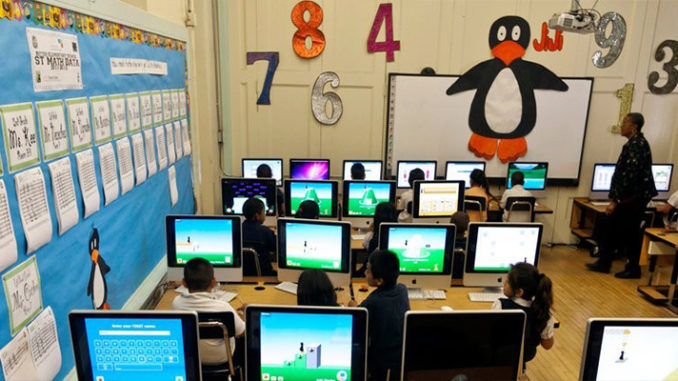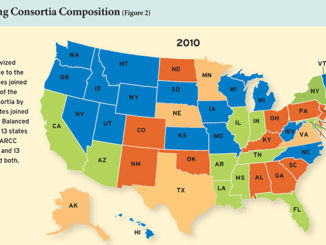
Despite efforts, diversity stalls at an elite public high school
There are 1,800 students at one of the best high schools in America, and thousands more vying to get in. The acceptance rate this spring at Thomas Jefferson High School for Science and Technology, a selective magnet school outside Washington, D.C., was just 15 percent—a touch lower than at nearby Georgetown University.
That’s as intended. Thomas Jefferson, or TJ, was designed to provide an elite, high-tech education for the most academically gifted students in Northern Virginia. Each day, select students from six Virginia jurisdictions enter TJ’s inspiring domed building for rigorous study in advanced college-level offerings like electrodynamics, neurobiology, and artificial intelligence. Every year, the AP participation, graduation, and college enrollment rates approach or hit 100 percent. So do the pass rates on statewide exams in all subjects. The school routinely tops high school rankings nationwide.
Other statistics are more troubling. TJ sits in Fairfax County, where 80 percent of its students live (the other 20 percent are from adjacent districts). Some 29 percent of students in Fairfax County Public Schools (FCPS), are from low-income families, compared to just one percent of students offered admission to TJ next fall (see Figure 1). The school’s newly accepted Class of 2022 is 65 percent Asian, 23 percent white, five percent Hispanic, and two percent black. The overall student enrollment at FCPS is 39 percent white, 25 percent Hispanic, 20 percent Asian, and 10 percent black.
These patterns may sound familiar: In New York City, for example, the most competitive of the city’s nine specialized high schools have similarly low numbers of black and Hispanic students, prompting Mayor Bill de Blasio to announce plans to overhaul admissions and ban the standard exam that prospective students must ace in order to enroll. A bill phasing out the test was recently approved by a state Assembly committee but put on hold by the speaker until next year, after attracting robust public protest, particularly by members of the city’s Asian-American community.
As in New York, the debate in Northern Virginia has been ongoing: The questions of who qualifies for admission to TJ, and how those admissions decisions are made, have generated criticism and controversy since the school’s founding in 1985. Because its enrollment has never resembled the overall enrollment of Fairfax County’s highly regarded school system, the reasonable assumption is that the county has not prioritized diversity or taken action to ensure TJ admissions were inclusive of underrepresented students. In fact, the opposite is true.
The two-decade history of TJ admissions is a story of successive changes to admissions policies and procedures and the expansions of outreach and the K-8 academic pipeline—all of which failed to change the numbers. It shows in painful detail how even the best public school systems cannot guarantee equity among students at the highest levels of academic achievement. How has a school system that has been able to create and sustain a school that succeeds at nearly everything failed so spectacularly to close the excellence gap?
Looking Inward: Adjusting an Admissions Process
Since its earliest years, TJ has been held up simultaneously as Fairfax County’s premier symbol of educational excellence and as evidence that its public schools are rife with systemic racial and economic inequalities. District and local leaders have sought to protect the first and rectify the second.
Entrance to TJ depends on a relatively complicated admissions process, which is handled by the school system’s TJ Admissions office. While the precise elements have shifted over time, students have always applied by taking an entrance exam and submitting school grades. TJ Admissions staff then creates a pool of semifinalists, who submit a Student Information Sheet, essays, and teacher recommendations. TJ Admissions considers all five components in making final decisions.
Through two decades of policy and procedural changes, the district has taken advantage of this complexity by manipulating virtually every step of the process with the express intention of increasing the number of students from underrepresented groups. Below, I review the major tactics.
Setting Quotas
One obvious approach to diversifying enrollment is to introduce quotas—an idea that was promoted earlier this year by a local state lawmaker representing a lower-income district within Fairfax County. State Sen. Scott Surovell proposed a bill to require a minimum of five and no more than 15 students from any middle school be admitted to TJ, along with a minimum number of low-income students. As soon as the bill was defeated in committee, a group of TJ alumni penned an open letter to the committee chair, urging TJ, the Fairfax County School Board, and the state legislature to take action to “combat the structural and systemic racism and class privilege that feeds students into the school.”
One might conclude that quotas never got a chance, but both race-based affirmative action and race-neutral quotas were among the district’s official TJ admission policies throughout the 1990s and beyond.
After the school’s initial graduating classes included relatively few black and Hispanic students, TJ Admissions created a referral committee to expand the enrollment of students from underrepresented groups. In making admissions decisions for the classes of 1997 through 2002, FCPS used this affirmative action program to admit black and Hispanic students whose test scores and grades ranked them below the qualifications of other students chosen for the semifinalist pool.
During a spate of legal challenges to similar race-based programs, including one at an Arlington elementary school, the county was forced to end racial preference. The effect was immediate and dramatic: The percentage of black and Hispanic students at TJ dropped from a high of 9.4 percent schoolwide in 1997-98, when all four classes included students admitted via race-based affirmative action, to a low of 3.5 percent in 2003-04, when no classes did (see Figure 2).
The district responded by instituting a quota similar to the one recently rejected by state lawmakers. Each class would include 30 additional students from “underrepresented” middle schools, which typically sent fewer than 10 students to TJ, with priority for low-income students.
This race-neutral quota was in place for three years, from 2001-02 to 2003-04. It failed to increase the number of black and Hispanic students admitted.
De-Emphasizing Exams
The Supreme Court’s June 2003 ruling in Grutter v. Bollinger, which restricted an educational institution’s consideration of a student’s race to instances where there are no workable race-neutral alternatives, effectively ended race-based affirmative action. Recognizing that such affirmative action was impermissible and that race-neutral quotas were ineffective at increasing the number of black and Hispanic students admitted to TJ, the district shifted its focus to neutralizing the entrance exam and minimizing its weight in the admissions process.
Since its inception, TJ applicants had been sorted first by test scores and grades, with scores weighted at 80 percent and grades at 20 percent. This initial review produced a semifinalist pool of the top 800 applicants, who were then reviewed further in order to select the roughly 400 students who would be accepted. However, after an outside committee’s review of TJ admissions concluded in 2004 that “the focus on a single test score in the process inhibits the school’s capacity to achieve its mission and fulfill the School Board’s commitment to diversity,” the district set about redesigning admissions procedures with the intent of increasing the diversity of applicants who would progress to the second round.
The admissions guidelines were revised to include a sliding scale where students with less than stellar test scores could be included in the semifinalist pool as long as their grades were high enough. The cap on the size of the semifinalist pool also was lifted, so more students could become eligible for a closer review. Students’ GPAs carried more weight and their test scores carried less, and because there was no limit on the number of students who could become semifinalists, the second-round pool doubled in size. The district also began admitting more students overall; since 2005, the size of the freshman class has been between 480 and 500 students.
Despite the changes, however, there was no statistically significant increase in the number of students admitted to TJ from underrepresented groups.
Swapping Achievement for Passion
In addition to changing admissions procedures to expand the semifinalist pool, the 2004 admissions policy included an express diversity goal tied to TJ’s mission to prepare scientific and technological leaders who could “address future complex societal and ethical issues.” Pursuant to this policy, second-round reviewers were to examine each student’s entire application for evidence of whether an applicant’s background, skills, or experiences promoted diversity.
As part of a second admissions overhaul in 2009, teachers were asked to do the same: a new letter from TJ Admissions advised teachers writing recommendations to consider diversity, “broadly defined to include a wide variety of factors, such as race, ethnicity, gender, English for speakers of other languages (ESOL), geography, poverty, prior school and cultural experiences, and other unique skills and experiences.”
TJ Admissions also adjusted how students reported their Science, Technology, Engineering, and Math (STEM) activities on their Student Information Sheets, swapping a focus on STEM clubs, teams, awards, and accomplishments for indications of “passion” for STEM subjects. Further, the guidelines for reviewing the new activities sheet advised evaluators not to assume that participation, even at a high level, indicated interest: “For example, if the student describes his/her most important accomplishment as ‘consistently scored highly in math team competitions in both 7th and 8th grade,’ raters should not assume that the student enjoys math . . . Rather this student would need to describe his/her enjoyment of math, . . .”
In addition to the above changes, the new guidelines also assigned a percentage weight to each required element of the application, which ensured that the admissions test would carry no more weight than the activities sheet and less weight than the essays. The district also established a 50-student wait list.
Together, these changes had the effect of reducing the number of top math students admitted to the school. An analysis conducted by the Fairfax County Association for the Gifted, a nonprofit advocacy group, showed that in 2011 during the Class of 2015 admissions cycle, TJ rejected over one-quarter of the applicants with scores in the top five percent on the AMC 8, a highly competitive national math exam, and rejected more than 100 of the 376 applicants with scores of 47 or higher on the math portion of the admissions test, which has a maximum score of 50.
Meanwhile, the number of admitted students from underrepresented groups did not budge. An analysis later conducted by TJ Admissions confirmed that even with a larger semifinalist pool, the number of black and Hispanic semifinalists applying for the Class of 2015 was so low that even if the second-round procedure had involved choosing an equal number of students by middle school or zip code or even random lottery, it would not have made a statistically significant difference in the percentage of students from underrepresented groups admitted.
Looking Outward: Expanding Equity-Minded Outreach
At the same time that it was manipulating the policies and procedures surrounding TJ admissions to get more black and Hispanic students admitted to TJ, the district also was working to increase the number of students who could be ready, able, and willing to apply.
Expanding Enrichment
Starting in 1992, a grant-funded outreach program called Visions identified promising black, Hispanic, and Native American middle-school students and provided them with guidance, mentoring, academic enrichment, and test-preparation programs beginning in 7th grade. The first cohort of TJ students who had participated in Visions graduated high school in 1998, when the district’s affirmative-action policies were also in effect. Benefiting from both outreach and affirmative action, they made up one of the highest percentages of black and Hispanic TJ graduates to date.
But when TJ ended its race-based affirmative action program in 1998, it replaced Visions with a less race-conscious program called Quest, which focused on low-income students as well as those from other groups underrepresented at TJ. Quest provided math and science enrichment sessions on alternate Saturdays during the second half of 6th grade and all of 7th grade, and for three weeks during the summers before and after 7th grade. In the fall of 8th grade, students participated in weekly test-prep sessions leading up to the TJ admissions exam.
When the district reviewed the program’s efficacy in 2008, it found that Quest had not increased the number of students from underrepresented groups admitted to TJ. Soon after the report was issued, the district began to phase the Quest program out.
In 2010, during the Class of 2014 admissions cycle, TJ Admissions renewed its commitment to outreach, hiring a new “outreach officer” to lead admissions presentations throughout the district and establish partnerships with the local NAACP chapter and school board advisory group focused on minority student achievement. These efforts temporarily increased the number of black and Hispanic students applying to TJ, but when that failed to result in any increase in admissions rates, interest dropped off.
More recent efforts have faired no better. In 2015, TJ won a two-year, $100,000 grant from the Jack Kent Cooke Foundation to provide up to 100 low-income 8th graders with fun summer STEM courses, confidence-boosting enrichment, mentorship, and test preparation. TJ’s nonprofit foundation funded the program for a third year. Citing privacy concerns, TJ declined to provide results, but admissions data indicate that the program has failed to increase the number of low-income students admitted. Another program for underrepresented students offered by a TJ alum who runs a test-prep center also has had limited success.
While its admissions and outreach efforts were ongoing, the district simultaneously was hard at work expanding access to advanced coursework in elementary and middle school, with the express intention of increasing the number of students from underrepresented groups in advanced high-school programs, including TJ.
Through its nationally recognized Young Scholars initiative, the district identified kindergarteners from underrepresented populations with the potential for academic excellence and provided enhanced curriculum and other accelerated learning opportunities to prepare them for advanced programs. After Young Scholars was begun in 2000, the share of black and Hispanic students in grades 3-8 participating in advanced academic programs grew district-wide, from four percent in 2001 to 15 percent in 2017.
To support the Young Scholars initiative, the district set annual goals to increase middle-school advanced program enrollment numbers for students from historically underrepresented populations, expanded middle-school honors classes, and requested “increased advocacy” and “adjustments as necessary to accommodate the Young Scholars students.” Pursuant to its plan to “remove criteria and advocate for inclusion of black and Hispanic students in honors classes,” the district gradually opened all middle-school honors classes to all students. By 2017, 83 percent of 7th and 8th grade Young Scholars students were enrolled in at least one honors course.
Unfortunately, the rapid and dramatic expansion of access to advanced programs, rather than widening the pipeline to TJ, had the unexpected effect of concentrating the TJ pipeline into an even narrower stream. FCPS enrollment data makes this clear. In 2001, 12 of the district’s two-dozen middle schools had fewer than 11 students accepted, and the five schools with the greatest number of admitted students accounted for 55 percent of acceptances. By 2016, the number of FCPS middle schools with no more than 10 students accepted had grown to 18, and the same five dominant middle schools accounted for 78 percent of admitted FCPS students.
Early Algebra for Everyone
No subject inspired as much concern over student readiness and eligibility than Algebra I. Although it was not until 2013 that TJ would officially require all 8th grade applicants to be enrolled in Algebra I, by that time it had been a de facto requirement for more than a decade.
The district had long identified middle-school Algebra as a “gatekeeper course for students on the road to advanced programs in high school.” In a 2002 internal review of TJ Admissions, FCPS found that black and Hispanic students accounted for almost one-quarter of students but fewer than 10 percent of 8th grade Algebra I students. In response, the district made access to early Algebra a key element in its strategy to improve TJ’s admission rates for students from underrepresented groups.
But at the same time that the district was committing itself to ensuring that more black and Hispanic students could access Algebra I in 8th grade, large numbers of students were beginning to accelerate their math coursework by taking Algebra I in 7th grade. TJ Admissions data reflects this trend. In 2005, 56 percent of admitted 8th grade applicants were enrolled in Algebra I, 38 percent in Geometry, and six percent in Algebra II or a more advanced course. By 2016, the vast majority of successful applicants had already progressed beyond the “gateway” class. Only seven percent of 8th grade students admitted to TJ were enrolled in Algebra I, with 64 percent enrolled in Geometry and 29 percent in Algebra II or a more advanced course.
As with its admissions and outreach efforts, expanding the pipeline by widening access to Algebra I and other advanced programs failed to increase the number of students from underrepresented groups admitted to TJ.
Failure as a Teachable Moment
Before we can make meaningful strides towards closing the excellence gap, we need to recognize what doesn’t work.
Over the last two decades, despite numerous policies and programs intended to increase the number of underrepresented students at TJ, and despite a steep rise in the percentage of Hispanic and low-income students in FCPS and surrounding districts, there has been no meaningful increase in the percentage of black, Hispanic, or low-income students at the school. It’s clear that manipulating admissions standards for this elite institution didn’t work, and that placing promising students in advanced programs and providing a few hours of test prep was not enough.
But during those same years, students from another group, one that was not targeted by these efforts, were vastly accelerating their acceptances and enrollment at TJ. While the district was engaged in an all-out effort to increase the number of underrepresented black, Hispanic, and low-income students, the percentage of Asian students at TJ grew to 68 percent by 2017-18 from 20 percent in 1995-96. The pace of growth for Asian students at TJ was much faster than in the district overall, where the percentage increased from 14 to 20 percent during that time. This enrollment trend is not unique to TJ; it is evident at elite high schools nationwide.
While data points to a higher-than-average application rate among Asian students, which suggests that Asian parents place a higher priority than others on the opportunity of early access to a college-level STEM education, that only begins to explain Asian students’ success at winning acceptance to the school. A 2018 survey of TJ parents reveals other factors behind the numbers. First, Asian parents disproportionately enroll their children, regardless of how gifted they are in math, in the advanced programs and STEM-related extracurricular activities at the middle schools that send the largest number of graduates to TJ. Second, many Asian parents have advanced degrees in STEM subjects and are able to tutor their children in these subjects. Finally, though most families of Asian TJ students have a relatively high income, Asian parents of all income levels invest in substantial weekend and summer enrichment.
Still, it is students, not parents, who apply to TJ, and the growing number of Asian students who win admission demonstrates the critical factor: preparation. It comes in the form of high-quality math instruction, particularly outside the classroom, and in the thousands of hours spent both engaged in, and preparing for, extracurricular STEM-related academic activities.
Before giving up on the potential of all capable students to succeed, we need to recognize that even the best public school systems—with the full weight of their political and economic resources aimed at eliminating disparities—cannot by themselves make up the difference between what some parents provide for their children and what others do not. Because all bright students have the potential to excel, we must find ways to provide the students of underrepresented groups access to the same preparation that the parents of admitted students provide for their children, and, along with it, a community of learners that encourages and supports their efforts.
The story of TJ is about much more than access to a particular school; it’s a case study of the challenging balancing act that newly diverse suburban school systems must perform. These districts must maintain top-flight programs in order to remain attractive to well-heeled families, who in turn maintain the tax base necessary to educate growing numbers of needy students. To preserve the strength of these elite institutions, they must admit only those students who are prepared to achieve. Yet, they also have an obligation to be as inclusive as possible and to work constantly against the evolution of a two-tiered educational system, with disparate opportunities separated by race and class.
Protecting both equity and excellence is a daunting task—but one worthy of every effort. If we’re serious about trying to close the persistent excellence gap that exists between groups of promising students, it helps first to agree on what hasn’t worked. Only then can we investigate and commit to strategies that could address the racial and economic disparities that hinder access to TJ and other elite programs like it across the country. Otherwise we may be left resorting to quick fixes that are unlikely to address these disparities, much less do anything to truly close the excellence gap.
Hilde Kahn is the parent of three Thomas Jefferson High School for Science and Technology graduates, a former Board member of TJ’s nonprofit foundation, and the author of “Closing the Excellence Gap.”





